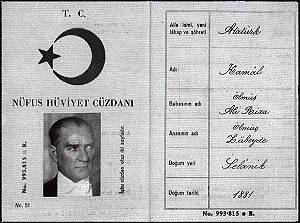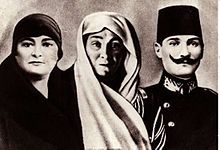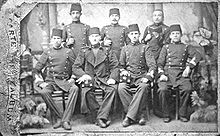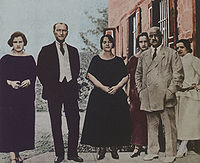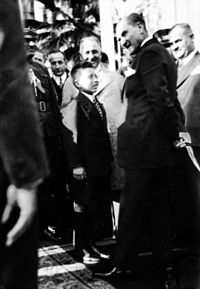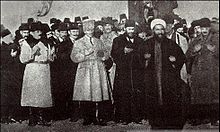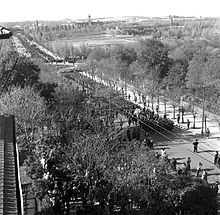- Mustafa Kemal Atatürk's personal life
-
Mustafa Kemal Atatürk 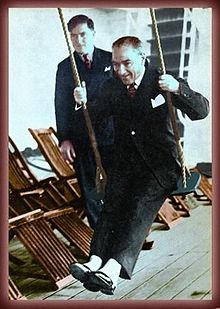
Atatürk on Ege steamer during a tour to Antalya, February 1935.Born Mustafa
May 19, 1881 (a posteriori)
Salonicaa (Thessaloniki), Ottoman EmpireDied November 10, 1938 (aged 57)
Dolmabahçe Palace, Istanbul, TurkeyCause of death Cirrhosis Resting place Anitkabir Nationality Turkish Education War College in Istanbul Height 1.68[1][2], according to Eren Akçiçek, 1.74[3], Photo Spouse Lâtife (1923–25) Children 7 (adopted) Parents Ali Rıza Efendi
Zübeyde HanımRelatives sister Makbule (Atadan) Signature 
Mustafa Kemal Atatürk (series) Personal life Birth date · Name · Early life (Education) · Family · Character · Religious beliefs · Will · Publications Military career Early period · Gallipoli · Caucasus · Sinai and Palestine Atatürk's Reforms & Kemalist ideology Gallery: Picture, Sound, Video The achievements, personality, and personal life of Mustafa Kemal Atatürk (May 19, 1881 a posteriori – November 10, 1938) born to Ali Rıza Efendi and Zübeyde Hanım have been the subject of numerous studies. According to the Turkish historian Kemal H. Karpat, Atatürk's recent bibliography included 7,010 different sources.[4] Atatürk's personal life has its controversies, ranging from where he was born to his correct full name. The details of his marriage have always been a subject of debate. His religious beliefs were discussed in Turkish political life as recently as the Republic Protests during the Turkish presidential election, 2007.
The personality of Mustafa Kemal has been an important subject both for scholars and the general public.[4] Much of substantial personal information about him comes from memoirs by his associates, who were at times his rivals, and friends. Some credible information originates from Ali Fuat Cebesoy, Kâzım Karabekir, Halide Edip Adıvar, Kılıç Ali, Falih Rıfkı Atay, Afet İnan, there is also secondary analysis by Lord Kinross, Sevket Sureyya Aydemir and recently Vamik D. Valkan, Norman Itzkowitz.
Contents
Name
In Turkish tradition, names have additional honorary or memorial values besides their grammatical identification function. It is possible to translate a name from Turkish to other languages, but care should be given as names' form varies from one language to another.
Mustafa
Atatürk had Mustafa (Mustapha) as his name at birth. Mustafa (Arabic: مصطفى - Muṣṭafā, "the chosen one"), an epithet of Islam's prophet Muhammad, was a common name at that time.
Mustafa Kemal
Young Mustafa studied at the military junior high school in Salonica (Salonica Military School), where his mathematics teacher Captain Üsküplü Mustafa Sabri Bey gave him the additional name Kemal ("perfection") because of his academic excellence.[5] Therefore he became known as "Mustafa Kemal".
Mustafa Kemal Bey
On November 27, 1911, Mustafa Kemal was promoted to the rank of Binbaşı (command of a thousand soldier). In Ottoman military ranks, Bey was a common title given to all levels above Binbaşı. Therefore Mustafa Kemal Efendi became called as "Mustafa Kemal Bey".
Mustafa Kemal Pasha
On April 1, 1916, Mustafa Kemal was promoted to the rank of Mirliva (brigade commander). In Ottoman military ranks, Pasha was a common title given to all levels above Mirliva. Therefore he became known as "Mustafa Kemal Pasha" (Turkish: Paşa). Disgusted by the capitulations and concessions made by the Sultan to the Allies, and by the occupation of Istanbul by the English, Kemal Pasha resigned from his post on July 8, 1919. He escaped from Istanbul by sea, through English Navy patrols and landed on an Anatolian port city named Samsun to organize the resistance to occupation of Anatolia by the Allied Powers. After his resignation, the Ottoman government issued a warrant and later condemned him to death in absentia.
Gazi Mustafa Kemal Pasha
On September 19, 1921, Turkish Grand National Assembly (GNA) presented him with the title Gazi (combat veteran and/or wounded veteran) with the rank of Marshal for his achievements during the War of Independence, hence "Gazi Mustafa Kemal". The GNA recognize his founding efforts during the national movement.
Gazi Mustafa Kemal Atatürk
On June 21, 1934, the GNAT recognized the need for registration, and use of fixed hereditary surnames. The Surname Law was proposed and later put into force. On November 24, 1934 the GNAT with a special law bestowed on "Mustafa Kemal" the surname "Atatürk".[6] The GNAT consecutively established the "Atatürk" as a unique surname. The surname Atatürk may be used only by "Gazi Mustafa Kemal Atatürk".
The surname Atatürk can be divided into two parts: Ata and Türk. Ata means "father" or "ancestor", while Türk means "Turk" or "Turkish People." Thus, "Atatürk" means "Father of Turkish People" or "Ancestor of Turkish People."
The current common use in Turkey is to refer to him by his last name Atatürk.
Birth date
Due to differences between calendars of the period, Atatürk's precise birth date is not known. The Ottoman Empire recognized the Hijri calendar and the Rumî calendar. The Hijri was an Islamic calendar, used to mark the religious holidays. It was lunar, with years of 354 or 355 days. The Rumi was a civil calendar, adopted in 1839. It was solar, based on the Julian Calendar. Both counted time from the Hijra, the flight of Muhammed to Medina. Between the two calendars significant differences in elapsed time were present. Various reforms were made to reconcile them but typically there was always a difference.
Atatürk's birth date was recorded in the public records of Turkish Selanik as Anno Hegirae 1296 with no sign whether this was based on the Rumî or on the Hijri calendar. In view of this confusion Atatürk set his own birthday to coincide with the Turkish Independence Day, which he announced was May 19, 1919, the day of his arrival in Samsun, in a speech given in 1927. His biological birth year cannot have been 1919, but his identification with Independence Day implied his selection of the civil calendar, in which AH 1296 lasts from 13 March 1880 to 12 March 1881. The latter dates are in the Gregorian Calendar just adopted for the Republic by Atatürk for purposes of standardization (the Julian Calendar was rejected earlier). Atatürk therefore listed his own birthday in all documents official and unofficial as May 19, 1881.[7]
Atatürk was told by his mother that he was born on a spring day.[citation needed] Yet, his younger sister Makbule Atadan was told by others that he was born at night during a thunderstorm.[citation needed] Faik Reşit Unat received differing responses from Zübeyde Hanım's neighbors at Salonika. Some claimed that he was born on a spring day, but others stated on a winter day during either January or February. A date that has gained some acceptance is May 19, a date which originated with the historian Reşit Saffet Atabinen. May 19 is the symbolic start of the Turkish Independence War, and Atabinen linked Atatürk's birth day to the start of the Independence War - a gesture which Atatürk appreciated.[citation needed] There was even a plan to establish a "Gazi" day. Another story about this date is that a teacher asked Atatürk his birth date, that he responded he did not know it, and that the teacher suggested May 19. Then again, there are two ways to interpret this; the "Gregorian May 19, 1881" would imply Rumî March 1, 1297, which conflicts with the only recorded information, Rumî 1296. It is also possible to say "Rumi May 19, 1296", which implies a date in the Gregorian year 1880.
Some sources ignore the day and month altogether, and print his birth date as Gregorian 1880/81. Other claims are:
- Enver Behnan Şapolyo claimed that Atatürk was born on Gregorian December 23, 1880.[citation needed]
- Şevket Süreyya Aydemir claimed that he was born on Gregorian January 4, 1881.[citation needed]
- Muhtar Kumral, former head of the Mustafa Kemal association, claimed that he was born on Gregorian 13 March 1881, and stated they used Makbule Atadan. A conversion from Gregorian to Rumî sets the day in Rumî to 1 March 1297. The validity of this claim is questionable, since the written record states Rumi 1296, not 1297.[8]
- Tevfik Rüştü Aras claimed that Atatürk was born between 10 May and 20 May. He also stated that this information was shared with Atatürk, and that Atatürk responded "Why not May 19."[citation needed]
The memoirs of the Soviet diplomat Simon Aralov mention a conversation between Aralov and Atatürk, where Aralov says he was born in 1880, and Atatürk responds "just like me".[citation needed]
Atatürk's last official identity document (Turkish: nüfus cüzdanı) does not include the day and month, but the year 1881 is visible.[8] It is exhibited in the Atatürk Museum in Şişli.[8] The Republic of Turkey announced 19 May 1881 officially to the public and diplomatically to other countries as his accepted birthday.[8]
Nationality
The Ottoman Empire was not a national state and the records were not kept based on nationality. People's native language was a major determination of their ethnic background[citation needed]. Atatürk's parents and relatives all[citation needed] used Turkish as their native language[9]. He later claimed that his family was part of a nomad Turkic tribe (Turkish: Yörük) settled in Balkans in 14-15 centuries. Many tribes settled in the newly conquered regions during that period. His statement is not supported or denied by documentary evidence.
Early life
Atatürk was born in the then Ottoman city of Salonika (Turkish: Selânik, modern-day Thessaloniki, Greece) to Ali Rıza Efendi and Zübeyde Hanım. He was born during the Belle Époque of European civilization. Russia was implementing reforms; Japan opened its doors to the West during the Meiji Restoration. The Ottoman Empire was going through transformation. Ottoman military reform efforts like the contemporaneous Modernization of Japanese Military 1868–1931 managed to develop a modern army. Racial, regional, ethnic and national stereotypes were part of discourse throughout the world. Ottoman people were not immune to these developments and there was a rise of nationalism under the Ottoman Empire. The Ottoman state was dynastic and medieval in its organising principles. Its Islamic dynamicism, which had propelled it to its golden age, had been weakened by Turkish nationalism for one. Conservatism was very strong both in government and society. Even though the Ottoman empire was transforming itself, the Hippocratic school of medicine, Ptolemaic astronomy and geography, and other branches of medieval studies were actively performed. Most of these studies had been first amended, then discarded in western Europe with the Age of Enlightenment. The Ottoman Empire never caught up with the Age of Enlightenment. Except for European military technology, the penetration of European ideas and practices was slow. These were the dominant characters of the period when he was born.
Ali Rıza Efendi was a minor civil servant who became a timber merchant.
Preparatory school
Ali Rıza Bey's desire was to send Atatürk to the newly-opened Şemsi Efendi Jewish Donmeh school (Rucholigè School). Şemsi Efendi school had a contemporary education program specializes in Judaism and Kabalism[citation needed]. Zübeyde Hanım wanted him to attend a traditional school. The traditional Muslim schools had programs based on mostly prayers and hymns. This caused arguments within the family. He was first enrolled in a traditional religious school. Later switched to a modern civic preparatory school, Rucholigè School.
In 1888, Ali Rıza Efendi died at an age of 47. Atatürk was 7 years old. Zübeyde Hanım was 31. Zübeyde Hanım and her two children lived with her brother Hüseyin for a period. Hüseyin was the manager of a farm outside Salonika. Mustafa worked on the farm.
Zübeyde Hanım married Ragıp Bey. Ragıp Bey was also a widower with four children. Atatürk liked Sureyya. His other step brother was employed by "Regie Compagnie interessee des tabacs de l'empire Ottoman." He was not the senior male in the house after his mothers marriage. He left the house and lived with a relative.
Military education
Atatürk wanted to attend the military school. As a young boy, he admired the Western-style uniforms of the military officers.
On March 13, 1899, he enrolled to the military junior high school Turkish: Selânik Askerî Rüştiyesi in Selânik. He was twelve years old.
In 1896, he enrolled in the Monastir Military High School. Monastir is today's Bitola, in the Republic of Macedonia. Both of these regions saw discontent and revolts towards the Ottoman administration.
On March 13, 1899, he enrolled in the Ottoman War Academy in Istanbul (Turkish: Mekteb-i Harbiye-i Şahane). It was a boarding school with dormitories within its premises. The military school was strictly controlled by Abdülhamid II. Newspapers were not allowed in the school, and textbooks were the only accepted books. The school not only taught military skills but also religious practices and social work. The curriculum at this school demanded either donating money or working for charity. He graduated from the Ottoman War Academy in 1902.
On February 10, 1902, he enrolled in the Ottoman Staff College in Istanbul. He graduated from Academy on January 11, 1905. There were two officer tracks in the Ottoman imperial army. One of them was the officers "educated within the army itself", Alaylı, and the other consisted of officers trained in modern military schools, Mektepli. He was a "school trained" officer. School educated officers had a strong ideological imprint toward family and country, and he had shown tendencies toward both. When he joined the Ottoman Army, he had already passed 13 years of military education.
Family
Zübeyde Hanım's first child was Fatma, then Ömer, later Ahmet was born. They all died in early childhood. Mustafa was the fourth child. Makbule followed him in 1885. Their sister Naciye was born in 1889. Naciye was lost to childhood tuberculosis.
Ragıp Bey had four children from his first marriage. In sequence, child1?, Surreyya, Hasan, and child4? were born. Sureeyya died during World War One. Ragip bey had a brother Colonel Husamettin[citation needed]. He and Vasfiye Hanım had a daughter named Fikriye (1897 - 31 Mayıs 1924). Fikriye was a lover to Mustafa while he was married to Latife.[10].
Out of the 9 siblings, 5 sharing at least one parent, only the biological sister Makbule (1885–1956) survived him.
Hacı Abdullah Ağa İbrahim Ağa Güzel Ayşe Hanım Feyzullah Ağa ?? Hafız Ahmet Efendi Husamettin[citation needed] Hüseyin Efendi Hasan Efendi Mehmet Emin Ragıp Bey Zübeyde Hanım Ali Rıza Efendi Fikriye Step 1 Fatma Sureeyya Ömer Hasan Ahmet Step 2 Mustafa Latife Makbule Abdurrahim (p) Naciye Sabiha (a) Rukiye (a) Zehra (a) Afet (a) Fikriye (a) Ülkü (a) Nebile Romances
In 1913 Kemal was stationed as military attache in the Bulgarian capital, Sofia. Here he befriended General Kovachev, the Bulgarian Minister of War, who had fought against him in the First Balkan War. Kemal and the general's daughter, an attractive and accomplished young girl named Dimitrina Zygote, with a slim figure and a head of dark curls, developed a romantic relationship. They frequently attended dance parties and masked balls. Kemal's consideration of asking Dimitrina's hand in marriage did not materialize since her family made their position known by politely refusing an invitation to a ball at the Turkish Embassy.[11]
While living in Şişli, Istanbul around 1917 Kemal also had an intimate relationship with Fikriye, a niece of his late stepfather, after her divorce from an Egyptian husband.[12]
Marriage
Atatürk married only once, to Latife Uşaklıgil; a multilingual, and self-confident woman who was educated in Europe and came from an established, ship-owning family from Izmir.
Atatürk met Latife during the recapture of occupied Izmir on September 8, 1922. Kemal was invited to Uşaklıgil residence during his stay in Izmir. He had chance to observe Latife closely. Their initial acquaintanceship period lasted relatively short as he had to return Ankara on October 2. Kemal opened up his interest to Latife by asking her "Don't go anywhere. Wait for me." On January 29, 1923, he arranged for the permission to marry from her family. The chief of staff Fevzi Çakmak asked the bride from her father. Kazim Karabekir was present at their wedding. These were not random decisions. In Turkish culture, groom asks his family or respected people with whom he has close relationships to perform this act. Latife did not cover her face during the wedding, though during this period it was the tradition for brides to do so. They did not have a honeymoon just after the wedding. The elections for the parliament was coming. He received the representatives of local newspapers next day of his wedding. He prepared for his public speech on February 2. The honeymoon, an Anatolian tour, was a chance to show his wife's unveiled face as a role model for modern Turkish women. "It's not just a honeymoon, it's a lesson in reform," one observer remarked.[13]
As a First Lady, she was part of the women's emancipation movement, which started in Turkey in the early 1920s. Latife showed her face to the world with a defiance that shocked and delighted onlookers.[13] She did not wear the hijab (tr:Carsaf en:Burqa) but covered her head with a headscarf (Turkish: Basortusu), a style of headcovering, and urged Turkish women to do the same.[14] Atatürk passed the women's rights to vote and to be elected. Latife lobbied for women's right to vote.[14]
One of the last public confrontations occurred during their Anatolian tour. Latife insisted on accompanying him to eastern towns even though the wife of other officials stopped at the Samsun and did not travel further to the devastated east. The attention of Atatürk was directed to conventional gatherings. The balance was hard to establish. At Erzurum, Latife and Kemal reached a breaking point. They had a public quarrel. Atatürk asked Latife to go to Ankara, with his trusted ADC Salih Bozok. They were divorced on August 5, 1925. The circumstances of their divorce remain publicly unknown. A 25-year-old court order banned the publishing of his former wife's diaries and letters, which might have contained information on the matter. Turkish History Foundation kept the letters since 1975. Upon expiration of the court order, the Turkish History Foundation said that Latife Uşaklıgil's family demanded that the letters not be disclosed.[15]
Children
 Adopted daughters of Mustafa Kemal; left to right: Zehra Aylin, Rukiye (Erkin) and Sabiha (Gökçen).
Adopted daughters of Mustafa Kemal; left to right: Zehra Aylin, Rukiye (Erkin) and Sabiha (Gökçen).
 Left to right: Rukiye (Erkin), Sabiha (Gökçen), Afet (İnan), and Zehra Aylin.
Left to right: Rukiye (Erkin), Sabiha (Gökçen), Afet (İnan), and Zehra Aylin.
He is quoted to have said: "Children are a new beginning of tomorrow." He established April 23 as "Children's day" and May 19 as "Youth and Sports day." Children's day commemorates the opening of Turkish National Assembly in 1920. The designation of Children's Day came in 1929 upon the recommendation of the Institution of Children's Protection. Both days are celebrated today. Youth and Sports is a national holiday. He did not have any children from his marriage. He had seven adopted daughters and one son. Additionally, he had two children under his protection, Abdurrahim and İhsan. The names of his children were Zehra Aylin, Sabiha (Gökçen), Rukiye (Erkin), Afet (İnan), Nebile (Bayyurt), Fikriye, Ülkü (Doğançay, later Adatepe), and Mustafa.[16]
In 1916, Atatürk took 8 years old Abdurrahim under his protection. He met Abdurrahim in Bitlis. His exact birth date and the parents unknown. There is a photograph showing Atatürk with his uniform during his assignment in Diyarbakir accompanied with the early teenage Abdurrahim. Abdurrahim was entrusted to Zubeyde Hanim's care. Abdurrahim stated that he does not remember his biological parents. This brought questions regarding if he was left orphan during the Caucasus Campaign. Abdurrahim stated that his earliest memories belong to the Zubeyde Hanim's house in Akarether. The house in Akarether was bought in 1913. Atatürk choose the surname Tunçak to Abdurrahim.
In 1924 Zehra from Amasya, Rukiye from Konya come to his protection. Zehra fell to her death from a train near Amiens on November 20, 1935. France police inquiry concluded that it was a suicide rather than an accident. On September 22, 1925, Atatürk adopted 12 years old girl Sabiha (Gökçen). She was an orphan girl who approached him at Bursa train station. She asked his help for education. Atatürk looked after her education. She was sent to Russia for training. She became the first female combat pilot in the world.
On October 25, 1925, Atatürk met 18 years old girl Afet (İnan). She was the daughter of a close family friend. She had lost her mother and her father had married another woman. She was trying to make a living in Izmir by teaching young girls. She lacked advanced education. Atatürk supported her advance education expenses, while she continued to support herself by teaching. Later, she became a trusted person. He asked her to copy edit his speeches, and dictate his materials.
In 1935, Atatürk met a three-year-old girl, Ülkü. She was the child of a retainer of his mother and the stationmaster. She was the only daughter that stayed close to him until a few weeks before his death.
Habits and talents
Atatürk mainly enjoyed reading, horse riding, chess, and swimming for leisure activities. He was very interested in dancing, taking pleasure in waltz on almost every opportunity, as well as the traditional Zeybek folk dances. He had an appreciation of Rumelian folk songs. Atatürk was fluent in French and German, and maintained a rich personal library of books on politics, history, chemistry, and linguistics.
He was known to have an appreciation for the national beverage, rakı, and enjoyed it in vast quantities.[17]
Character
1937, at the rose garden with Ülkü
 Atatürk on Ege steamer during a tour to Antalya, February 1935.
Atatürk on Ege steamer during a tour to Antalya, February 1935.
According to Atatürk:
“ There is one trait I have had since my childhood. In the house where I lived. I never liked to spend time with my sister or with a friend. Since my childhood I have always preferred to be alone and independent, that is how I always lived. I have another trait: I have never had any patience with any advice or admonition which my mother - my father died very early - my sister or any of my closest relatives pressed on me according to their lights. People who live with their families know that there are never short of innocent and sincere warnings from left and right. There are only two ways of dealing with them. You either ignore them or obey them. I believe neither way is right [18] ” One changing view about Atatürk is his foresightedness, foster and promotion of the leadership among Turkish revoutionaries[19]. Initial reviews depict him as an unchallanged leader, the single man. Recent studies analyze the period from the populist perspective. His leadership activities had extending effects on the political, social and cultural context of the Republic[19]. These studies gives clues on his abilities to foster the cooperation among different people, such as in the "History of National Struggle Volumes I through V"[20]. His significance during independence was cited for his ability to unify people. It is pointed out that organizations in the countryside for resistance against occupation was happening effectively before his involvement. His ability to channel people did not. The foundation for the civilian participation in the government [parliament being never closed during his reign] and establishment of civic society [his insistence of keeping military out of daily politics] are cited having the roots in the Kemal's presidency, not after[19]. The failed reforms of the regional countries, after the passage of its leaders, were generally used as an example of the Atatürk's leadership among the Turkish Revolutionaries. His effect lasted many years after his passage.
Love of nature
He attached importance to his horse Sakarya and his dog Fox. He was also anecdotally linked to preservation of Turkish Angora after an article in the Turkey's Reader's Digest reportedly claimed that Atatürk said "his successor would be bitten on the ankle by an odd-eyed white cat[21].
Atatürk established the Atatürk Forest Ranch "Atatürk Orman Çiftliği" in 1925. He wanted to have a modern farm in the suburbs of the capital including a green haven (arboretum) for people[22]. The Atatürk Forest Ranch developed a program to introduce domesticated livestock and horticulture in 1933. As a consequence of children being interested in the animals Atatürk involved in developing a program which then became known as "Ankara Zoo[23]." The modern zoo which took 12 years in making, first of its kind in Turkey, gave a chance to people observe animals beyond the boundaries of Circus and Fairs. Atatürk, with his smallest adapted daughter "Ulku" spend his time at the Forest Ranch and throughout the development stages of the Zoo until he died in 1938. The official opening was in 1945.
Religious beliefs
In his youth, he underwent religious training, though it was short. His military training included religious imprinting. He knew the Arabic language well enough to understand and interpret the Quran. He studied the "History of Islam" by Leone Caetani and the "History of Islamic Civilization" by Georgi Zaidan. He authored the chapter in "Islamic History" himself when he wanted history books for high schools prepared. Atatürk's religious knowledge was considerably high in its nature and level[24] Ethem Ruhi Fığlalı states that one can clearly conclude on the basis of his speeches and attitudes that he was a sincere believer[24]. Atatürk has stated, "He [Muhammed] is Allah's first and greatest human-being. Today, in his footsteps, millions are walking. Your and my name would get erased someday but he, eternally, is immortal.[25] According to Reşat Kasaba, Mustafa Kemal was not the only Agnostic in the Turkish ruling class, but there were few who matched his purely instrumental attitude to religion.[26]
General perception
Atatürk's general view regarding religion was positive. In his speeches and publications there is no trace connoting hostility or even indifference toward religious ideology.[24] He viewed religion as a necessary and unavoidable institution within the matter of relationship and communication between the individual and God. His positive views did not extend to the prejudiced confessors of religion. In his view, the problem is not the religion but what he named as "prejudiced confessors." Prejudiced confessors according to him were "people who misuse religion for their earthly gains".[27]
Atatürk stated that a religion should be in conformity with reason, science and logic. He viewed Islam as in complete harmony with the reasoning, science and logic.[28] The problem was not religion, but how believers understood and applied religion. True religion could not be understood as long as false prophets isolated and religious knowledge is enlightened. The only way to deal with false prophets was to deal with the Turkish people's illiteracy and prejudice.[29]
Religion and the individual
Religion, particularly Islam, was between an individual and God in Atatürk's eyes. [30]. When compared to Ottoman practice (political Islam integrated to government life through Millets), Atatürk believed in a form of reformed Islam (Islam between individual and God). He believed it was possible to blend native tradition (based on Islam) and Western modernism harmoniously.[31] In this equation, he gave more emphasis towards the modernization. His modernization aimed to transform social and mental structures (native traditions of Islam) to eradicate the irrational ideas, magical superstitions and so on.[31]
Atatürk was not against religion but what he perceived as all Ottoman religious and cultural elements that brought limits to people's self being.[31] He concentrated his reforms (regarding popular sovereignty) against obstacles for the individual choices being reflected in the social life. He viewed civil law and abolition of caliphate was required for reflection of individual choices. He perceived religion as a matter of conscience, a problem of worship, but not politics. The best response on this issue comes from himself
“ "Religion is a matter of conscience. One is always free to act according to the will of one's conscience. We (as a nation) are respectful of religion. It is not our intention to curtail freedom of worship, but rather to ensure that matters of religion and those of the state do not become intertwined.[32]" ” Atatürk believed in freedom of religion, but he was a secular thinker and his concept of freedom of religion was not limitless. He differentiated between social and personal practice of religion. He applied social considerations (secular requirements) when the public practice of religion was considered. He said that no one can force another to accept any religion or a sect (freedom of belief) [33]. Also, everyone has the right to perform or neglect, if he so wishes, obligations of any religion he chooses (freedom of worship), such as the right to not to fast during Ramadan.[34]"
Religion and politics
According to historian Kemal Karpat, the movements that perceive Islam as a political movement or particularly the view of Islam as a political religion hold the position that Atatürk was not a Muslim (true believer or religious Muslim). It is normal that this perspective was adapted, Karpat says. "He was not against Islam, but those who are against his political power using the religious arguments[4]." Any movement that wanted to establish the Caliphate had to discredit Atatürk. It is claimed that Republic reflected Kemal's personal philosophy.
“ I have no religion, and at times I wish all religions at the bottom of the sea. He is a weak ruler who needs religion to uphold his government; it is as if he would catch his people in a trap. My people are going to learn the teachings of science.... Let them worship as they will; every man can follow his own conscience, provided it does not interfere with sane reason or bid him act against the liberty of his fellow man.[35] ” Many years later, when Turkey had became more secular and modern, he gave a public speech in which he criticized the Islamic political views related them to as a religion (political views attributed to religion) as a religious of an 'immoral Arab' (rules and theories of an Arab Shaikh):
“ For nearly five hundred years, these rules and theories of an Arab Shaikh and the interpretations of generations of lazy and good-for-nothing priests have decided the civil and criminal law of Turkey. They have decided the form of the Constitution, the details of the lives of each Turk, his food, his hours of rising and sleeping the shape of his clothes, the routine of the midwife who produced his children, what he learned in his schools, his customs, his thoughts-even his most intimate habits. This theology of an immoral Arab [presented as Islam] is a dead thing. Possibly it might have suited tribes in the desert. It is no good for modern, progressive state. God's revelation! There is no God! These are only the chains by which the priests and bad rulers bound the people down. A ruler who needs religion is a weaklings. No weaklings should rule![36] ” It can be claimed that Atatürk is a "cultural Muslim" or "nominal Muslim," but it should be noted that the definition of cultural Muslim itself is very far from being uncontested[citation needed].
Mustafa Kemal described the religion of Islam as the religion of Arabs in his own work titled Medenî Bilgiler:
“ Even before accepting the religion of the Arabs, the Turks were a great nation. After accepting the religion of the Arabs, this religion, didn't effect to combine the Arabs, the Persians and Egyptians with the Turks to constitute a nation. (This religion) rather, loosened the national nexus of Turkish nation, got national excitement numb. This was very natural. Because the purpose of the religion founded by Muhammad, over all nations, was to drag to an including Arab national politics.[37] ” Last days, 1937–1938
During 1937, indications of Atatürk's worsening health started to appear. In the early 1938, while he was on a trip to Yalova, he suffered from a serious illness. After a short period of treatment in Yalova, an apparent improvement in his health was observed, but his condition again worsened following his journeys first to Ankara, and then to Mersin and Adana. Upon his return to Ankara in May, he was recommended to go to İstanbul for treatment, where he was diagnosed with cirrhosis of the liver.
During his stay in İstanbul, he made an effort to keep up with his regular lifestyle for a while, heading the Council of Ministers meeting, working on the Hatay issue, and hosting King Carol II of Romania during his visit in June. He stayed onboard his newly arrived yacht, Savarona, until the end of July, after which his health again worsened and then he moved to a room arranged for him at the Dolmabahçe Palace.
Funeral
Main article: State funeral of Mustafa Kemal AtatürkAtatürk died at the Dolmabahçe Palace in Istanbul, on November 10, 1938, 09:05am, at the age of 57. It is thought that he died of cirrhosis of the liver.[38] Atatürk's funeral called forth both sorrow and pride in Turkey, and seventeen countries sent special representatives, while nine contributed with armed detachments to the cortège.[39]
On November 1953, Mustafa Kemal's remains were taken from the Ethnography Museum of Ankara by 138 young reserve officers in a procession that stretched for two miles (3 km) including the President, the Premier, every Cabinet minister, every parliamentary deputy, every provincial governor and every foreign diplomat, while at the same time 21 million Turks stood motionless all over the country.[40] One admiral guarded a velvet cushion which bore the Medal of Independence; the only decoration, among many others held, that Atatürk preferred to wear. The Father of the Turks finally came to rest at his mausoleum, the Anıtkabir. An official noted: "I was on active duty during his funeral, when I shed bitter tears at the finality of death. Today I am not sad, for 15 years have taught me that Atatürk will never die."[40]
His lifestyle had always been strenuous. Alcohol consumption during dinner discussions, smoking, long hours of hard work, very little sleep, and working on his projects and dreams had been his way of life. As the historian Will Durant had said, "men devoted to war, politics, and public life wear out fast, and all three had been the passion of Atatürk."
Will
In his will written on September 5, 1938, he donated all of his possessions to the Republican People's Party, bound to the condition that, through the yearly interest of his funds, his sister Makbule and his adopted children will be looked after, the higher education of the children of İsmet İnönü will be funded, and the Turkish Language Association and Turkish Historical Society will be given the rest.
Publications
Atatürk published many books and kept a journal throughout his military carrier. Atatürk’s daily journals and military notes during the Ottoman period were published as a single collection. Another collection covered the period between 1923–1937 and indexes all the documents, notes, memorandums, communications (as a President) under multiple volumes, titled Atatürk'ün Bütün Eserleri (All Works of Atatürk).
The list of books edited and authored by Atatürk is given below ordered by the date of publication.
- "Tâbiye Meselesinin Halli ve Emirlerin Sureti Tahririne Dair Nesayih"
- "Takımın Muharebe Talimi", published in 1908 (Translation from German)
- "Cumalı Ordugâhı—Süvari: Bölük, Alay, Liva Talim ve Manevraları", published in 1909
- "Tâbiye ve Tatbikat Seyahati", published in 1911
- "Bölüğün Muharebe Talimi", published in 1912 (Translation from German)
- "Zabit ve Kumandan ile Hasbihal", published in 1918
- "Nutuk", by Mustafa Kemal, published in 1927
- "Vatandaş İçin Medeni Bilgiler", published in 1930 (For high school civic classes)
- "Geometry", by Mustafa Kemal, published in 1937 (For high school math classes)
See also
Notes
- ^ Haşmet Babaoğlu, "Atatürk'ün boyu posu!", Sabah, February 28, 2010.
- ^ Atatürk için diyorlar ki!, Ministry of Culture and Tourism
- ^ "Yani? Atatürk'ün boyu kaçmış?", Hürriyet, November 19, 2003.
- ^ a b c Karpat, "The Personality of Ataturk", pages 893-899
- ^ Carl Cavanagh Hodge, Encyclopedia of the Age of Imperialism, 1800-1914, p.393 ISBN 9780313334047
- ^ Turkish Justice Department website, Article Ataturk
- ^ Zürcher, Erik Jan (1984). The Unionist factor: the rôle of the Committee of Union and Progress in the Turkish National Movement, 1905-1926. Leiden: E. J. Brill. p. 106.
- ^ a b c d "Atatürk'ün Doğum Tarihi" (in Turkish). http://www.ahmetakyol.net/index.php?option=com_content&task=view&id=224&Itemid=45. Retrieved 2011-07-09.
- ^ Mango, Atatürk, 27
- ^ Mango, Atatürk, 38
- ^ Lord Kinross, Ataturk, 1964, pp.165, William Morrow and Company.
- ^ Lord Kinross, Ataturk, 1964, pp.77, William Morrow and Company.
- ^ a b Turgut, Pelin (2006-07-01). "Turkey in the 21st century: The Legacy Of Mrs Ataturk". The Independent. http://news.independent.co.uk/europe/article1152032.ece. Retrieved 2007-09-29.
- ^ a b Güler, Emrah (2006-08-25). "Atatürk, his wife and her biographer". Turkish Daily News. http://www.turkishdailynews.com.tr/article.php?enewsid=52361. Retrieved 2007-09-29.
- ^ BBC News Atatürk diaries to remain secret (Friday, 4 February, 2005)
- ^ Terra Anatolia—Mustafa Kemal Atatürk (1881–1938)
- ^ Volkan, "Immortal", pages 221–255
- ^ Şevket, Tek Adam: Cilt I, Page: 20
- ^ a b c Karpat, "The Personality of Ataturk" page 897-898
- ^ Mahmut Goloğlu, (1971) Milli Mucadele Tarihi 5 Cilt (The history of national Struggle volumes I through V)
- ^ "Turkish Angora A Zoological Delight". "Pet Publishing Inc.". http://www.petpublishing.com/catkit/breeds/angora.shtml. Retrieved 2007-11-26.
- ^ "History of Ataturk Orman Ciftigi". aoc@aoc.gov.tr. Archived from the original on 2007-10-10. http://web.archive.org/web/20071010040005/http://www.aoc.gov.tr/tarihce.html. Retrieved 2007-11-26. ""Yeşili görmeyen gözler renk zevkinden mahrumdur. Burasını öyle ağaçlandırınız ki kör bir insan dahi yeşillikler arsında olduğunu fark etsin" düşüncesi Atatürk Orman Çiftliği'nin kurulmasında en önemli etken olmuştur."
- ^ "Ataturk Orman Ciftigi Hayvanat Bahcesi". aoc@aoc.gov.tr. http://www.ankarazoo.gov.tr/tarihce.htm. Retrieved 2007-11-26. "Ulu Önder Atatürk, zamanýn Tarým Bakaný Muhlis ERKMEN’ e, daha modern bir hayvanat bahçesi kurulmasý direktiflerini vermiþlerdir."[dead link]
- ^ a b c Ethem Ruhi Fığlalı (1993) "Atatürk And The Religion Of Islam" Ataturk Aarastirma Merkezi Dergisi, Sayı 26, Cilt: IX.
- ^ Dr. Utkan Kocatürk, Atatürk'ün Fikir ve Düşünceleri (Atatürk ve Din Eğitimi, A. Gürtaş, s. 26)
- ^ Reşat Kasaba, "Atatürk", The Cambridge history of Turkey: Volume 4: Turkey in the Modern World,Cambridge University Press, 2008, ISBN 9780521620963 p. 163.
- ^ Kılıç Ali, Atatürk'ün Hususiyetleri, Ankara, 1930, p. 116.
- ^ Atatürk'ün Söylev ve Demeçleri, Ankara 1959 - 2nd. ed., vol. 11, p. 90.
- ^ Nutuk, vol. 11, p. 708.
- ^ Fığlalı "Atatürk And The Religion Of Islam" quote="But to mention that religion is a matter of relationship and communication between Allah and his servant [recited from Kılıç Ali, Atatürk'ün Hususiyetleri, Ankara, 1930, p. 116]."
- ^ a b c Jacob M. Landau (1984). Atatürk and the Modernization of Turkey. London ; New York: Univ. Chicago Press. ISBN 9004070702. page 217
- ^ M.Orhan Tarhan "Should Government Teach Religion?" The Atatürk Society of America
- ^ Kılıç Ali, Atatürk'ün Hususiyetleri, Ankara, 1930, p. 57
- ^ A. Afet İnan, M. Kemal Atatürk'ten Yazdıklarım,İstanbul, 1971, pp. 85-6.
- ^ Ruşen Eşref Ünaydin, 1954, "Atatürk -Tarih ve Dil Kurumları Hatıraları" Türk Tarih Kurumu. page 28-31.
- ^ Harold Courtenay Armstrong (1932). Grey Wolf: Mustafa Kemal – An intimate study of a dictator , pp. 199-200.
- ^ Afet İnan, Medenî Bilgiler ve M. Kemal Atatürk'ün El Yazıları, Türk Tarih Kurumu, 1998, p. 364.
- ^ "Kemal Atatürk". NNDB. http://www.nndb.com/people/449/000092173/. Retrieved 2007-08-07.
- ^ Mango, Atatürk 526
- ^ a b "The Burial of Atatürk". Time Magazine: pp. 37–39. Monday, 23 November 1953. http://www.time.com/time/magazine/article/0,9171,860125,00.html. Retrieved 2007-08-07.
References
- Prints
- Vamik D. Volkan and Norman Iskowitz (1984). The Immortal Atatürk. A Psychobiography. London ; New York: Univ. Chicago Press. pp. 374. ISBN 978-0226863894.
- Mango, Andrew (2002) [1999]. Ataturk: The Biography of the Founder of Modern Turkey (Paperback ed.). Woodstock, NY: Overlook Press, Peter Mayer Publishers, Inc. ISBN 1-58567-334-x.
- Mango, Andrew (2004). Atatürk. London: John Murray. ISBN 978-0719565922.
- Şevket, Süreyya Aydemir (2003). Tek Adam: Cilt I. Remzi Kitabevi. ISBN 9751406722.
- Journals
- Karpat, Kemal H.; Volkan, Vamik D.; Itzkowitz, Norman (October 1985). "The Personality of Ataturk". The American Historical Review (New York: Macmillan) 90 (4): 893–899. doi:10.2307/1858844. JSTOR 1858844.
- Volkan, Vamik D. (1981). "Immortal Atatürk—Narcissism and Creativity in a Revolutionary Leader". Psychoanalytic Study of Society (New York: Psychohistory Press) 9: 221–255. ISSN 0079-7294. OCLC 60448681.
- Fığlalı, Ethem Ruhi (1993). "Atatürk And The Religion Of Islam". Atatürk Arastirma Dergisi (Ankara: Atatürk Araştırma Merkezi Başkanlığı) IX (26). http://www.atam.gov.tr/index.php?Page=DergiIcerik&IcerikNo=540.
- News
- "The Burial of Atatürk". Time Magazine: pp. 37–39. Monday, 23 November 1953. http://www.time.com/time/magazine/article/0,9171,860125,00.html. Retrieved 2007-08-07.
- Web
- "Mustafa Kemal Atatürk". Turkish Embassy website. Archived from the original on 2007-09-27. http://web.archive.org/web/20070927211519/http://www.turkishembassy.org/index.php?option=com_content&task=view&id=300&Itemid=317. Retrieved 2007-08-07.
- "Kemal Öz adlı Cümhür Reisimize verilen soyadı hakkında kanun" (in Turkish). Turkish Justice Department website. http://www.mevzuat.adalet.gov.tr/html/1117.html. Retrieved 2007-08-26.
Categories:- Mustafa Kemal Atatürk
- Religious views by individual
Wikimedia Foundation. 2010.

